August 17, 2023
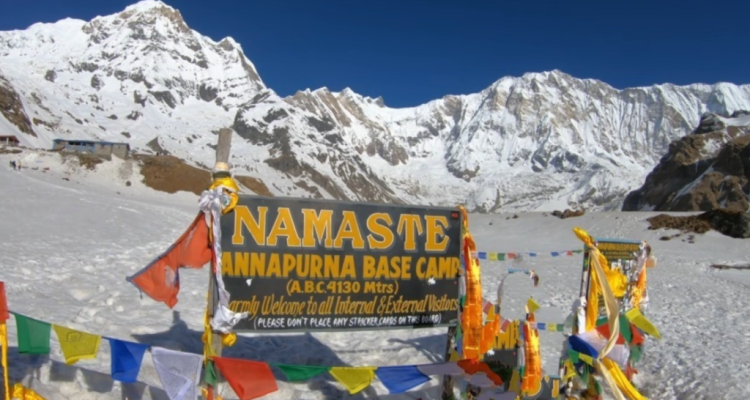
The cost of the Annapurna Base Camp trek can vary significantly based on a range of factors, ultimately falling within the broad range of 450 to 1000 USD. This variation is influenced by several crucial elements that prospective trekkers should consider. Firstly, the duration of the trek plays a pivotal role in determining the overall cost, as longer itineraries involve more expenses for accommodation, meals, and permits. Additionally, the level of comfort desired also impacts the cost, with budget options being more economical compared to luxury packages that offer enhanced amenities. Other variables include transportation to and from the starting point of the trek, as well as the inclusion of a guide or porter services, both of which contribute to the overall expenses. By understanding these factors, trekkers can better navigate their options and tailor their Annapurna Base Camp trek experience to their preferences and budget constraints.
Opting to join a group for the 8 days Annapurna Base Camp trek offers both practical and social advantages. Group treks often provide a cost-effective solution for budget-conscious travelers, as the shared expenses for accommodations, meals, and transportation can significantly lower individual costs. This can make the trek more accessible and affordable, especially for solo travelers.
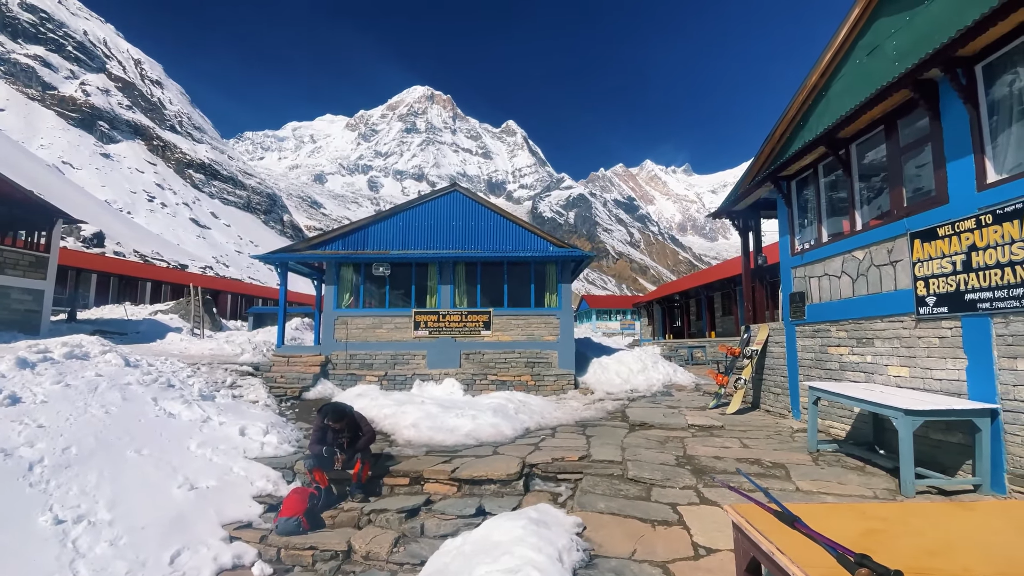
Beautiful Annapurna Base Camp-4130m
Beyond the financial benefits, group treks foster a sense of camaraderie and community among participants. Sharing the journey with fellow trekkers from diverse backgrounds can enrich the experience through shared stories, laughter, and mutual support during challenging segments of the trek. Moreover, traveling in a group ensures safety and navigation, as professional guides are usually part of the package, offering valuable insights into the region’s culture, history, and natural wonders.
However, it’s essential to select a group and trekking company that aligns with your preferences and fitness level. Larger groups might provide a livelier atmosphere but could also lead to less personalized attention. Smaller groups might be more intimate but can come with slightly higher costs. Careful research and communication with the trekking company will help you find the right group size and itinerary that suits your expectations and enhances your Annapurna Base Camp trekking experience.

If you’re planning to do the ABC (Annapurna Base Camp) trek in Nepal and are looking to hire a guide and porter, it’s a good idea to arrange these services in Kathmandu or Pokhara before starting your trek. This will ensure that you have a smoother experience and can communicate effectively with your guide and porter.
In general, the cost of hiring a guide and porter for trekking in Nepal can vary based on factors such as the duration of the trek, the level of experience of the guide, and the services included. As of my last update in September 2021, the prices you mentioned (guide cost around $30 per day and porter cost between $22 and $25 per day on average) seem reasonable.
The cost of a typical Annapurna Base Camp Trek can vary depending on various factors such as the duration of the trek, the level of comfort you seek, the time of year you’re traveling, and whether you’re hiring a guide and porter or trekking independently. Here’s a general breakdown of the costs involved:
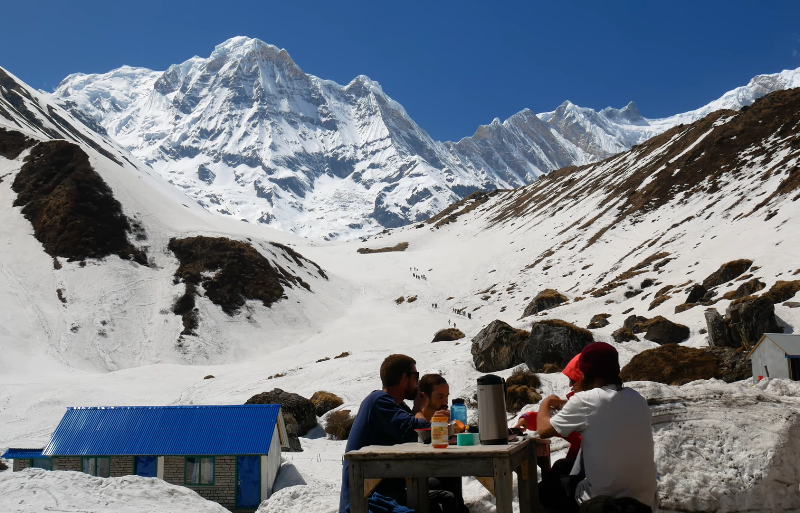
at MBC during ABC trek
Permits and Fees:
Annapurna Conservation Area Permit (ACAP): Usually around $20-30 for foreign tourists.
Trekkers’ Information Management System (TIMS) Card: About $10-20.
Transportation:
Flights to/from Kathmandu (if applicable): Prices can vary greatly based on your departure location and the time of year. Budget anywhere from $200 to $600 or more for international flights.
Transportation to/from the trailhead: If you’re starting from Nayapul, you might need to hire a taxi or take a bus. This cost can vary.
Accommodation:
Tea Houses/Lodges: Along the trail, there are tea houses and lodges where you can stay. The cost per night can vary but is usually around $20 to $40 for a basic room. Remember that prices can be higher at higher altitudes.
Food and Water:
Meals: The cost of meals can vary, but budget around $15 to $25 per day for food.
Water: Bottled water prices increase as you go higher in elevation. It’s recommended to budget for filtered or boiled water to reduce plastic waste and costs.
Guide and Porter (if hired):
Guide: A licensed guide can provide valuable insights, cultural information, and ensure your safety. Their daily cost can range from $20 to $40 or more.
Porter: If you choose to hire a porter to carry your heavy backpack, their cost can range from $15 to $30 or more per day. They can carry around 20-25 kg of weight.
Equipment and Gear:
Trekking gear: If you need to rent or buy equipment such as trekking poles, sleeping bags, and down jackets, this could add to your costs.
Miscellaneous Expenses:
Souvenirs, snacks, extra drinks, tips, and any unforeseen expenses.
Travel Insurance:
It’s strongly recommended to have travel insurance that covers trekking at higher altitudes and emergency evacuation.
Currency Exchange and ATM Fees:
Keep in mind that there might be currency exchange fees or ATM withdrawal fees.
Overall, a rough estimate for the total cost of a typical 10-14 day Annapurna Base Camp Trek could range from $500 to $1500 or more, depending on the factors mentioned above. It’s important to research thoroughly, plan ahead, and be prepared for potential fluctuations in costs.
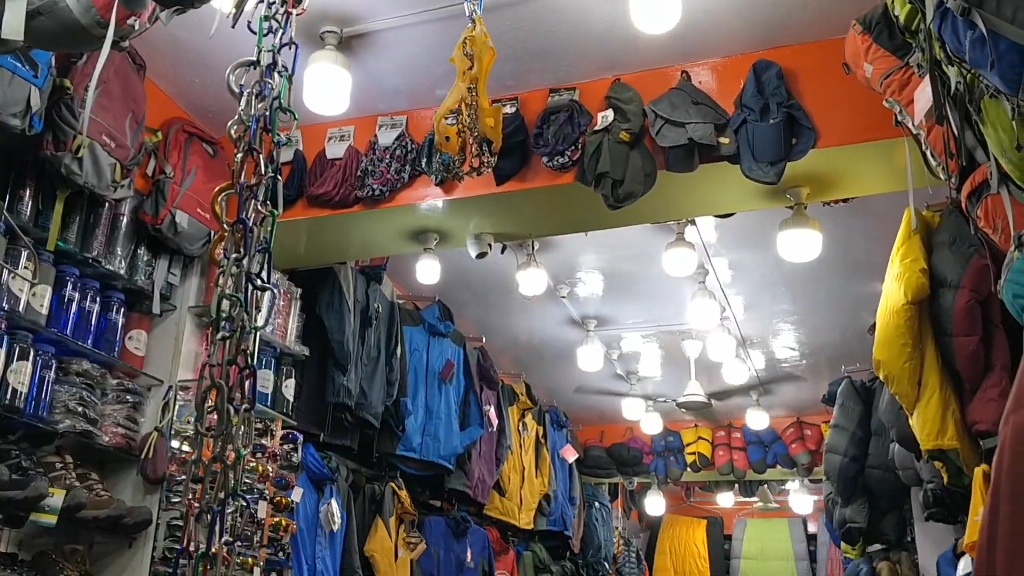
Trekking gears for EBC trek
Clothing:
Moisture-wicking base layers
Insulating layers (fleece or down jacket)
Waterproof and windproof jacket
Trekking pants (convertible pants are convenient)
Thermal underwear for colder nights
Waterproof trekking boots
Woolen or synthetic socks
Sun hat and beanie
Accessories:
Sunglasses with UV protection
Gloves (both lightweight and insulated)
Sunscreen and lip balm with SPF
Quick-drying towel
Gear:
Backpack (40-60L capacity)
Sleeping bag suitable for cold temperatures
Trekking poles
Headlamp with spare batteries
Water bottles or hydration system
Snacks and energy bars
Health and Hygiene:
First aid kit (including altitude sickness medication)
Personal medications
Hand sanitizer
Wet wipes
Toilet paper
Electronics:
Camera and spare batteries
Portable charger/power bank
Plug adapter for Nepal
Footwear:
Lightweight camp shoes or sandals
Extra shoelaces
Documents:
Passport
Permits and TIMS card
Travel insurance documents
Emergency contact information
Miscellaneous:
Trekking map and guidebook
Cash (Nepali rupees) for small expenses
Ziplock bags (for keeping things dry)
Trash bags (to carry out your waste)
Several factors influence the cost of the Annapurna Base Camp Trekking in Nepal. Firstly, the duration of the trek plays a significant role – longer treks tend to be costlier due to increased accommodation and food expenses. The choice of route also matters, with different trails having varying permit fees. The time of year affects costs, as peak trekking seasons can lead to higher prices for accommodation and guides. The inclusion of services such as guides, porters, and transportation also impacts the overall cost. Additionally, personal expenses like equipment, travel insurance, and meals can add to the total expenditure, making it essential to budget wisely for this unforgettable adventure.
Embarking on the Annapurna Base Camp Trekking while keeping costs in check requires some strategic planning. Here are some tips to help you have a budget-friendly trek:
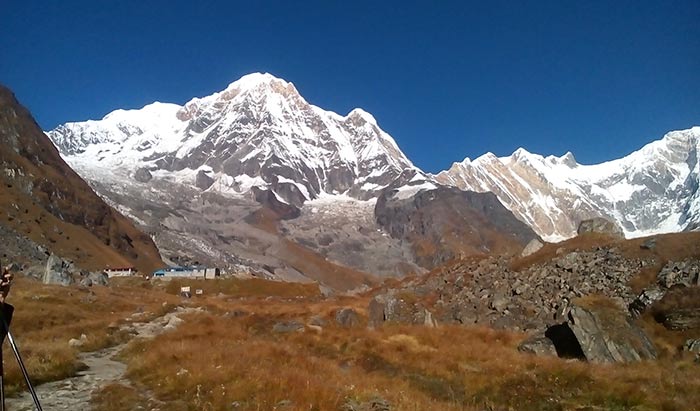
Stunning Annapurna south mountain view from Annapurna base camp
Independent Trekking: Going without a trekking agency can save money on guide and porter fees. However, be prepared for more self-reliance in terms of navigation and logistics.
Accommodation: Opt for teahouse lodges over luxury hotels. They offer basic amenities at lower costs. Negotiate room prices, especially during the off-peak season.
Food and Water: Stick to local dishes, as imported or specialty foods can be pricier. Choose purified water or use water purification tablets to avoid purchasing bottled water.
Trekking Season: Plan your trek during the shoulder seasons (spring and autumn), as these periods offer the best weather and lower costs compared to peak seasons.
Permits and Fees: Research and understand the required permits and entry fees, and carry the necessary documents to avoid last-minute expenses.
Sharing Costs: If you’re traveling solo, consider finding trekking partners to share the cost of guides, porters, and transportation.
Guide and Porter: If you opt for a guide or porter, hire them directly rather than through an agency to save on fees.
Equipment: Rent or borrow trekking gear before the trip, as buying equipment locally can be more expensive. Pack essentials and avoid overloading with unnecessary items.
Local Transportation: Use local buses or shared jeeps to reach the starting point of the trek. This is more cost-effective than private transportation.
Plan Ahead: Book accommodation in advance for popular stops to avoid higher prices due to limited availability during peak times.
Pack Snacks: Carry energy bars, nuts, and other lightweight snacks to keep you fueled between meals, which can save money on buying extra food.
Stay Healthy: Prioritize your health to avoid medical expenses. Carry a basic first aid kit and practice proper hygiene to prevent illnesses.
Negotiate: When hiring services or buying items along the trek, don’t hesitate to negotiate prices. Locals often expect some bargaining.
Travel Light: The weight of your backpack can affect your trek’s overall cost if you need to hire a porter. Pack efficiently to minimize unnecessary expenses.
Inclusions:
Permits and fees
Accommodation in teahouses
Meals (breakfast, lunch, dinner)
Licensed guide and porter
Transportation to/from trailhead
Airport transfers (sometimes)
Pre-trek briefing
Essential trekking gear (sometimes)
Emergency support
Exclusions:
International flights
Travel insurance
Personal expenses
Tips for staff
Additional activities
Meals outside trek
Alcohol and beverages
Personal equipment
Optional extras not specified
The cost of Annapurna Base Camp trekking experiences seasonal variations. During the peak trekking seasons of spring (March to May) and autumn (September to November), the cost tends to be higher due to favorable weather and clear mountain views, attracting a larger number of trekkers. Prices for accommodations, permits, and guides may rise during these times. In contrast, the off-seasons of summer (June to August) and winter (December to February) see fewer trekkers due to monsoon rains and extreme cold. During these periods, costs can be lower as businesses offer discounts to attract trekkers willing to navigate the challenging weather conditions.
When booking Annapurna Base Camp Trekking, it’s important to be aware of potential hidden costs that can arise beyond the initial package price. These include:
Permits and Entry Fees: You’ll need various permits to enter the Annapurna Conservation Area and other restricted areas. These permit fees may not be included in the upfront cost.
Accommodation Extras: While basic accommodations might be included, additional charges could arise for amenities like hot showers, charging electronic devices, or extra blankets.
Food and Drinks: Some packages might not cover all meals and beverages, especially snacks and bottled water during the trek.
Guide and Porter Expenses: If you have guides and porters accompanying you, you’ll need to cover their fees, accommodations, meals, and even tips.
Transportation: If the trek doesn’t start and end at the same place, transportation to and from the trek’s starting and ending points might not be included.
Emergency Costs: Unforeseen events like altitude sickness or injuries might require emergency evacuation, which can be expensive and often isn’t covered by standard packages.
Additional Activities: Side trips, sightseeing, or cultural experiences outside the trekking route may incur extra costs.
Gear Rental: If you don’t have your own trekking gear, you might need to rent equipment like trekking poles, sleeping bags, or down jackets.
Currency Conversion Fees: If paying in foreign currency or using credit cards, keep in mind potential currency conversion fees or international transaction charges.
Tipping: While not mandatory, it’s customary to tip guides, porters, and other support staff at the end of the trek.
To avoid surprises, thoroughly read through the itinerary and contract, asking for clarification on any potential hidden costs. It’s a good idea to have some extra funds set aside to cover these unforeseen expenses and ensure a smoother trekking experience.

Crossing suspension bridge at Thikhedunga during Ghorepani Poon hill trekking
The Annapurna Base Camp trek can be undertaken both in a group or solo. Opting for a group trek offers companionship, safety, and shared costs. Group treks typically include guides, porters, and organized accommodations, making logistics easier. Solo treks provide greater flexibility in terms of pace and schedule, allowing a more personalized experience. However, solo trekkers need to manage logistics, permits, and safety precautions themselves. Both options offer stunning mountain vistas, cultural interactions, and the satisfaction of reaching the base camp. The choice depends on one’s preference for social interaction, independence, and comfort with trek planning.
More About Annapurna base camp(ABC) Trek: